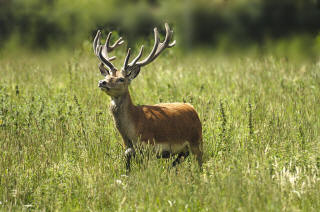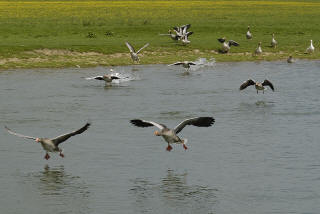|
Article
Bird and Animal Behaviour
This article looks at animal behaviour to
humans and what we can do to be able to photograph them.
| Wildlife reactions to us Some wildlife is tame, for example common garden
birds. Some hardly notice your existence, such as butterflies, bees, and
most bugs. A very wide variety will quickly get used to anything that is
static and does not move a lot, for example a garden shed, swinging garden seat
with cover over, child's tent, caravan or parked cars.
If you don't hide, but stay reasonably still
and quiet, a
wide variety of birds and animals will, within a reasonable short time, get to
realise that you are not a danger to them, and if you put out food for them,
they will of course be attracted far faster. Some animals will run away when
they first encounter you, but if after several encounters you never gave chase
or did anything to harm them then they will get nearer to you. Often younger
ones are more daring, as are those that are hungrier.
|

 A Deer
A Deer |
| For a period
we lived in a country farmhouse, the last house in a village, about 5 miles north of
Cheltenham. While there we encouraged a wide range of wildlife into the
garden, we had two
feeding stations, near to windows on two sides of the house, and took a lot of
wildlife photos. Before we put up the feeding stations we saw quite a few birds,
but once we put them up the number and variety increased rapidly. The garden of
the farmhouse was a part of an ancient orchard, and had a range of large trees.
Behind us was a steam railway and beyond that a hill with a lot of woodland, and
across the road, fields, a mixture of green fields and nearer to us cereal
growing crops. When birds see something that they feel may be
a predator, some just take flight, while many instead just keep it in sight.
This is how the duck decoys work, a small fox like dog is led along a bank and
the ducks keep it in sight, swimming into a tunnel trap. When you walk through
woodland or just go into your garden, some birds will move around so as to keep
you in sight, and if you sit down, and stay still, some will come closer to see
what you are up to, and what you are, before deciding if to leave or not. Others
just hide, they have a territory, and they don't want to give this up, or enter
another territory, and if you are in their territory they just stay out of
sight, but usually will keep an eye on you. In many cases you will notice that
of a pair you see only one at a time, but if you look around you will often find
the other is in a good position keeping watch. Over a period they come to trust
you, and I found that very many birds would come very near me, and I regularly
had a number of partridges and pheasants around my feet, and woodpeckers brought
their young to be fed next to me. Not all birds are the same, some species are far
more timid and take flight at a far earlier point and individual birds have
their own personalities so while one of a pair may allow you close enough to touch
it, its mate may run around in a large circle or keep a greater distance away.
I discovered that having birds around attracted
more birds, including species that did not feed from the food provided. In some
cases you did get a single bird one day, but after it went off to roost
overnight it brought back a small group the following day, often made up of
several pairs. |
| Information appears to get around, and they
seem to make some sense of what they had seen. Birds occasionally flew into the
house windows and were then stunned by this, so you could go and pick them up and
check them over, before putting them somewhere safe for them to recover. Doing
this is not a cause of concern to the other birds. Even on one occasion where I took
an injured bird around to the garden and placed it under the feeder, and a
larger bird decided to then make a meal of it, the other birds did not
react differently to me. One day however a green woodpecker flew out of the
garden and directly into the side of a passing coach, which killed it. These shy
birds are difficult to get very close to, so I was interested in taking a closer
look, and like anything that died or was killed in the garden, I put it in the
wooded area near the railway, as for something or other it was a meal. However
some birds must have seen this and it caused concern as for about a week after,
although the birds came and fed in the garden, none of any species would allow me
to get anywhere near them. Over a few weeks it got back to normal. |

 Flying Geese
Flying Geese |
| We had many mammals as well, a
vast number of rabbits lived in the railway embankment and they would
regularly visit the
garden, bringing their young with them, different types of mice, rats, squirrels, a fox occasionally and
most nights we were visited by badgers, who liked to clean up behind the
birds. The squirrels moved into one of our trees so we had baby squirrels
and the badgers brought the whole family to play and fight on the lawn.
Rabbits of course have many young throughout the year. In addition we had
bats in the porch and barn, voles and shrews, plus just occasionally saw a
stoat or weasel but not close enough or for long enough to determine which.
At night you could watch the bats, see owls
hunting and of course look out for the badgers.
I didn't wear the same clothes or use
camouflage generally in the garden. On odd occasions when I put on camo
clothing, and went out the birds all took flight. Not surprising I suppose when
you consider that many of the local farmers shot game birds, rabbits etc. When
there was shooting going on, a lot of the birds would fly into our garden,
including many that did not regularly visit us.
I like most creatures but we did need to
control rats as they could do damage to the buildings, and any mice that got
into the house, also needed to be trapped. Rats I found, both there and at
other properties I had previously, are extremely bright, and are very
difficult to trap. I had a humane trap that was supposed to be able to trap
rats but none ever fell for this. You can catch mice in bated snap traps,
but rats won't generally go near them. The rats became tame in one of our
barns and when I went in there they would come out on to the roof rafters
and watch me, and also raid the bird feeders. I have no problem with
killing rats but I didn't want to injure one and for it to go away and suffer, so I
decided to fire water pistols at them, just knocking them over. They got the
message and all moved out.
Of course if you're not lucky enough to
have a garden to be able to do this, or if away from your natural
environment you want to be able to photograph wildlife then it may be
necessary to invest in some camouflage items such as hides which can hide
both you and your camera, but also camouflage clothing which can help you to
blend in with the natural surroundings and therefore not be as visible to
the wildlife. However this is not always successful some birds are not
always confident with the camouflage monster moving around in it's habitat.
See our article
Hides and
Camouflage
 for a more detailed look at this.
for a more detailed look at this.
|
See Also
Wildlife photography

Equipment suitable for
wildlife photography

Hides and Camouflage

General tips on
photographing wildlife

Introducing Birds

Where to Photograph
UK Wild Birds

Squirrels and How to
Photograph Them

Where to
photograph Red Squirrels
 |